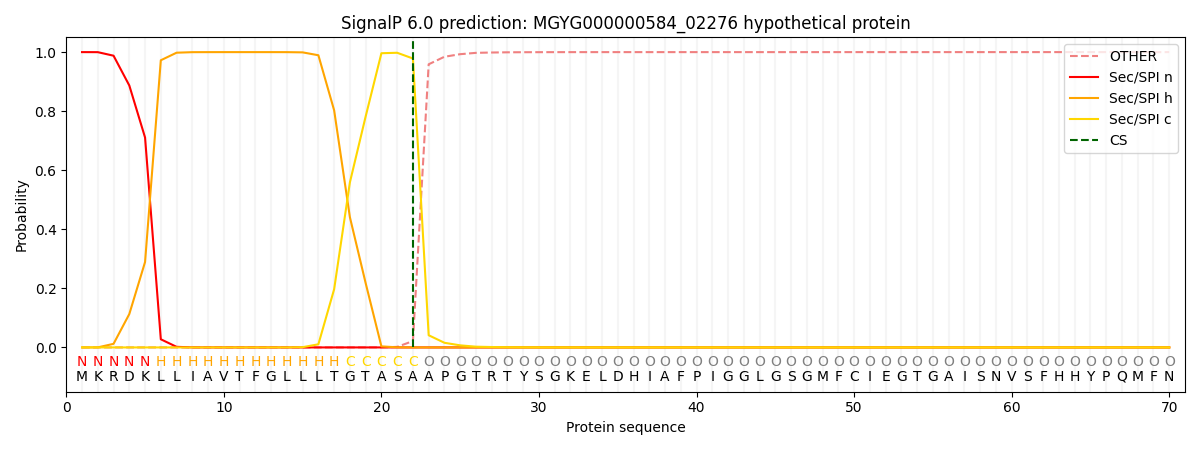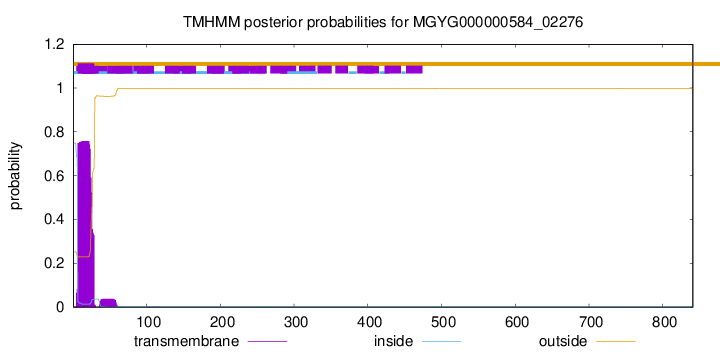You are browsing environment: HUMAN GUT
CAZyme Information: MGYG000000584_02276
You are here: Home > Sequence: MGYG000000584_02276
Basic Information |
Genomic context |
Full Sequence |
Enzyme annotations |
CAZy signature domains |
CDD domains |
CAZyme hits |
PDB hits |
Swiss-Prot hits |
SignalP and Lipop annotations |
TMHMM annotations
Basic Information help
| Species | RC9 sp900544195 | |||||||||||
|---|---|---|---|---|---|---|---|---|---|---|---|---|
| Lineage | Bacteria; Bacteroidota; Bacteroidia; Bacteroidales; UBA932; RC9; RC9 sp900544195 | |||||||||||
| CAZyme ID | MGYG000000584_02276 | |||||||||||
| CAZy Family | GH116 | |||||||||||
| CAZyme Description | hypothetical protein | |||||||||||
| CAZyme Property |
|
|||||||||||
| Genome Property |
|
|||||||||||
| Gene Location | Start: 6564; End: 9089 Strand: - | |||||||||||
CAZyme Signature Domains help
| Family | Start | End | Evalue | family coverage |
|---|---|---|---|---|
| GH116 | 397 | 770 | 2.8e-61 | 0.9944903581267218 |
CDD Domains download full data without filtering help
| Cdd ID | Domain | E-Value | qStart | qEnd | sStart | sEnd | Domain Description |
|---|---|---|---|---|---|---|---|
| pfam04685 | DUF608 | 8.74e-67 | 397 | 770 | 1 | 362 | Glycosyl-hydrolase family 116, catalytic region. This represents a family of archaeal, bacterial and eukaryotic glycosyl hydrolases, that belong to superfamily GH116. The primary catabolic pathway for glucosylceramide is catalysis by the lysosomal enzyme glucocerebrosidase. In higher eukaryotes, glucosylceramide is the precursor of glycosphingolipids, a complex group of ubiquitous membrane lipids. Mutations in the human protein cause motor-neurone defects in hereditary spastic paraplegia. The catalytic nucleophile, identified in UniProtKB:Q97YG8_SULSO, is a glutamine-335, with the likely acid/base at Asp-442 and the aspartates at Asp-406 and Asp-458 residues also playing a role in the catalysis of glucosides and xylosides that are beta-bound to hydrophobic groups. The family is defined as GH116, which presently includes enzymes with beta-glucosidase, EC:3.2.1.21, beta-xylosidase, EC:3.2.1.37, and glucocerebrosidase EC:3.2.1.45 activity. |
| pfam12215 | Glyco_hydr_116N | 1.26e-47 | 38 | 355 | 1 | 309 | beta-glucosidase 2, glycosyl-hydrolase family 116 N-term. This domain is found in bacteria, archaea and eukaryotes. This domain is typically between 320 to 354 amino acids in length. This domain is found associated with pfam04685. It is found just after the extreme N-terminus. The N-terminal is thought to be the luminal domain while the C terminal is the cytosolic domain. The catalytic domain of GBA-2 is unknown. The primary catabolic pathway for glucosylceramide is catalysis by the lysosomal enzyme glucocerebrosidase. In higher eukaryotes, glucosylceramide is the precursor of glycosphingolipids, a complex group of ubiquitous membrane lipids. Mutations in the human protein cause motor-neurone defects in hereditary spastic paraplegia. The catalytic nucleophile, identified in UniProtKB:Q97YG8_SULSO, is a glutamine-335 in the downstream family pfam04685. |
| COG4354 | COG4354 | 5.57e-36 | 26 | 778 | 2 | 721 | Uncharacterized protein, contains GBA2_N and DUF608 domains [Function unknown]. |
CAZyme Hits help
| Hit ID | E-Value | Query Start | Query End | Hit Start | Hit End |
|---|---|---|---|---|---|
| QUT37400.1 | 0.0 | 27 | 836 | 34 | 844 |
| QBJ18460.1 | 0.0 | 27 | 836 | 34 | 844 |
| QDO68263.1 | 0.0 | 27 | 836 | 33 | 843 |
| QNL50572.1 | 0.0 | 29 | 837 | 59 | 869 |
| QUT60790.1 | 0.0 | 29 | 839 | 34 | 851 |
Swiss-Prot Hits download full data without filtering help
| Hit ID | E-Value | Query Start | Query End | Hit Start | Hit End | Description |
|---|---|---|---|---|---|---|
| Q9HCG7 | 4.76e-16 | 114 | 740 | 219 | 848 | Non-lysosomal glucosylceramidase OS=Homo sapiens OX=9606 GN=GBA2 PE=1 SV=2 |
| Q69ZF3 | 1.13e-13 | 114 | 740 | 210 | 839 | Non-lysosomal glucosylceramidase OS=Mus musculus OX=10090 GN=Gba2 PE=1 SV=2 |
| Q5M868 | 5.84e-13 | 114 | 740 | 210 | 839 | Non-lysosomal glucosylceramidase OS=Rattus norvegicus OX=10116 GN=Gba2 PE=2 SV=2 |
| Q7KT91 | 2.52e-08 | 493 | 735 | 687 | 893 | Non-lysosomal glucosylceramidase OS=Drosophila melanogaster OX=7227 GN=CG33090 PE=1 SV=1 |
SignalP and Lipop Annotations help
This protein is predicted as SP

| Other | SP_Sec_SPI | LIPO_Sec_SPII | TAT_Tat_SPI | TATLIP_Sec_SPII | PILIN_Sec_SPIII |
|---|---|---|---|---|---|
| 0.000285 | 0.999014 | 0.000193 | 0.000182 | 0.000164 | 0.000142 |

